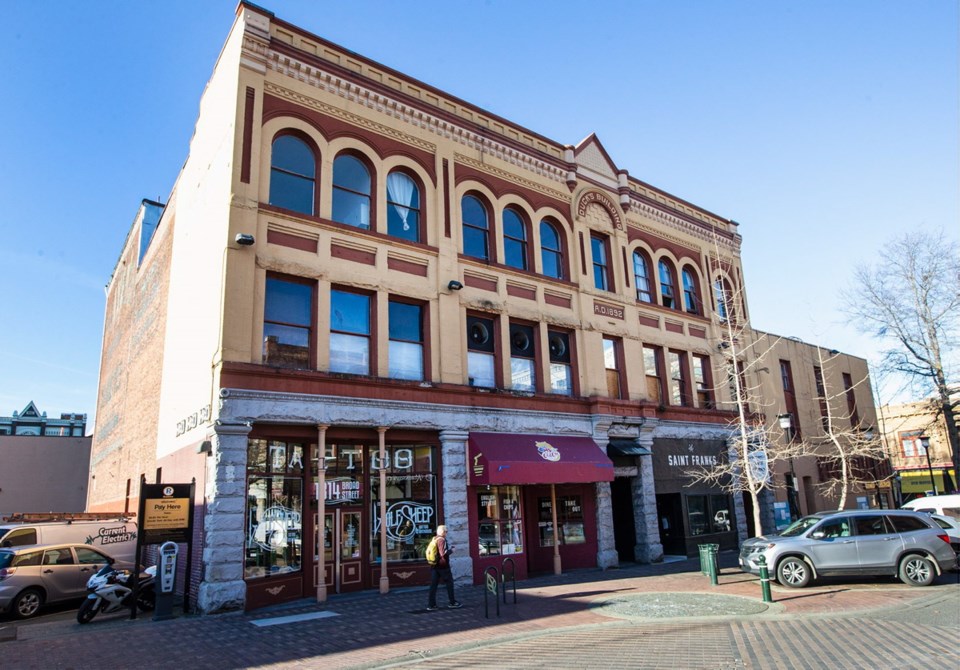Victoria city councillors have decided to hear from residents about a controversial plan to demolish significant portions of two heritage buildings in Old Town to make way for a new hotel.
At a committee of the whole meeting Thursday, councillors voted 5-3 to send the project to a public hearing that Mayor Lisa Helps predicted will be “big and long.”
The proposal has already divided the city’s heritage community with preservationists and developers at odds over the future of the Duck's Building and the adjacent Duck's Carriage Factory, also known as the Canada Hotel at Broad and Johnson streets.
The properties are among those bequeathed to the University of Victoria by the late Michael Williams, the developer and businessman behind Swans Brew Pub and Restaurant.
UVic Properties and Chard Development want to use the site to build a 139-room hotel covering nearly a full block of Broad Street.
Their proposal preserves the front and rear walls and parts of the side walls of the 127-year-old Duck’s building, as well as an original rock wall of the Carriage Factory, which dates to 1874.
Developer David Chard has argued previously that new building code rules make it difficult to preserve any more of the Duck’s Building, while still ensuring the safety of occupants in the event of a major earthquake.
As for the Carriage Factory, he argues that the building has been substantially altered over the years, leaving only the rock wall worthy of protection.
Since the project was last before council in November, the developers have made a number of revisions to reduce the project’s density and increase the prominence of the Duck’s Building façade. They propose, as well, to take apart the building’s interior layer by layer and salvage some of the historic materials such as bricks and timber floor joists for use in the hotel’s common areas.
In addition, the developers have offered to contribute $80,000 to the city’s housing reserve fund to compensate for the loss of eight residential units if the project goes ahead.
City staff supported the project previously and say the revisions “bring the development even further in line with prevailing policy and guidelines.”
Helps said she felt strongly that it was time to send the project to public hearing. “Especially with the revisions that have been made, I really do see the Duck’s Building as being preserved,” she said. “When we walk down the street, we’re going to feel like we’re walking past the Duck’s Building as it was originally constituted with two new buildings alongside of it”
Coun. Geoff Young was sympathetic to the project as well, arguing that it meets the “higher goals” of heritage preservation.
He acknowledged that it’s a good idea to preserve an entire building where practical. “But where that’s not the case — and we can’t do it everywhere — the most important and fundamental aspect of a building is what we can see.”
Coun. Ben Isitt disagreed. He said the University of Victoria, as the property owner, should be encouraged to entirely restore both heritage properties or, at the very least, the Duck’s Building.
“This is one of the oldest buildings in the community,” he said. “It was there long before I got here and I hope it’s here long after I’m here.”
He added that there seems to be a “disconnect” between the project and the university’s considerable expertise at dealing with heritage assets in a sensitive way, including by operating museums and galleries.
“I think there’s a number of other revenue streams available [to the university] short of essentially liquidating an asset for profit,” he said.
“If there isn’t an interest in refurbishing these buildings, I think the best outcome would be finding a purchaser who would pursue the approach that has been pursued by literally dozens of property owners ... that doesn’t require the demolition of heritage buildings.”
Other councillors admitted to being conflicted on the issue and said they will wait to hear from the public before making a final decision.
“This has been a difficult one for me,” said Coun. Charlayne Thornton-Joe. “I have to know that 10 years from now, when I walk down Broad Street, I can say I made the right decision.
“So I’m willing for it to go to public hearing to hear the comments, and at that time I’ll be able to decide whether it has reached that bar.”



